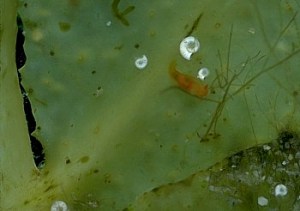
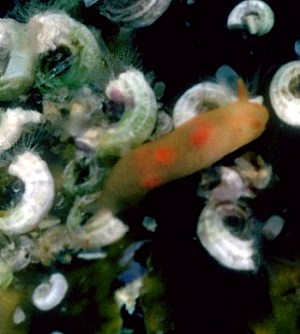
Vayssierea felis
(Collingwood, 1881)
Order: NUDIBRANCHIA
Suborder: DORIDINA
Superfamily: ANADORIDOIDEA
Family: Vayssiereidae
DISTRIBUTION
Indo-West Pacific
PHOTO
UPPER: Vayssierea felis with tube worm, Spirorbis on brown alga (Ecklonia) with epiphyic algae. 5mm long.
LOWER: Vayssierea, 6mm long, amongst living Spirorbis on which it feeds. The bright red-orange spots in the body are developing eggs. Egg masses consist of a group of 3-5 eggs, which develop directly hatching as small crawling juveniles.
Both from Coffs Harbour region, northern New South Wales, December 1990. PHOTOS: Bill Rudman.
Collingwood first described this species from the South China Sea. Because of its small size and lack of gills he considered it to be most probably a juvenile of a species of Gymnodoris (Trevelyana). He found specimens in tide pools and described it as `very active and flexible, assuming at different times the most singular of forms, resembling in turn a fox, a rabbit, a cat, according to its different attitudes.' Although no internal anatomy was described, the size, colour, lack of gills, simple rhinophores and rapid movement and flexibility, clearly characterise this species which has been found, under various names in many parts of the Indo-West Pacific. Collingwood queries whether his species is a juvenile of the earlier named gymnodorid Stenodoris rubra Pease, 1866. Vayssierea caledonica, from New Caledonia, Okadaia elegans from Japan and Pellibranchus cinnabareus from New Zealand, are all the same colour and the major features of their anatomy are identical. They all feed on spirorbid or similar tube worms, live in the intertidal zone and have direct development. The only feature distinguishing them has been the morphology of the radular teeth. In an animal so small, it is not surprising that different interpretations of the radular morphology have been reported from light microscope preparations. Risbec described a radula with two lateral teeth on each side and no rachidian, while both Ralph and Baba reported three lateral teeth on each side, the inner two teeth varying in denticulation in each species. More recently, Young has redescribed the teeth of specimens from Okinawa and reported for the first time a small rachidian tooth. I have prepared SEM mounts of specimens from New Caledonia which are identical to Young's description. I would consider all the earlier descriptions of the radular teeth to be attempts to describe the same morphology. Consequently Vayssierea caledonica is the earliest name for which we have anatomical information. However, as discussed above, Collingwood's description of Trevelyana felis from the South China Sea is clearly this species. Both Baba (1937) and Risbec (1953) refer to T. felis as a possible synonym or close relative. While species with direct development do not usually have widespread distributions, the relationship of this species to Spirorbis and other fouling tubeworms, suggests that this species has become widely distributed, either artificially, on the bottom of boats, or on floating laminarian algae, a common site for spirorbid settlement. As well as its wide distribution in the western Pacific, it is also reported from South Africa (Gosliner, 1987a) and Tanzania (personal observation).
See V. felis References.
See V. felis - Radular Morphology.
NOTE added 19 April 2000: My suggestion that there may be only one widespread species of vayssiereid, which I am identifying here as Vayssierea felis has generated some long and thoughtful responses, for which I am very grateful. One of my aims for the Forum is to generate such discussion. I am putting all these responses, whether they agree with the 'one species' concept or not, on this page, at least temporarily. This does not mean I have made up my mind and am ignoring contrary views, just that it would be very difficult and time-consuming to set up new pages, then amalgamate them every time a new idea came in. Hopefully this discussion will reach the stage where we can resolve this issue and then I will rearrange the pages .... once. Bill Rudman.
Authorship detailsRudman, W.B., 2000 (April 12) Vayssierea felis (Collingwood, 1881). [In] Sea Slug Forum. Australian Museum, Sydney. Available from http://www.seaslugforum.net/find/vaysfeli
Related messages
Vayssierea felis from sthn Queensland
September 12, 2008
From: Gary Cobb
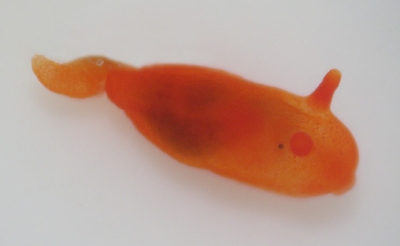
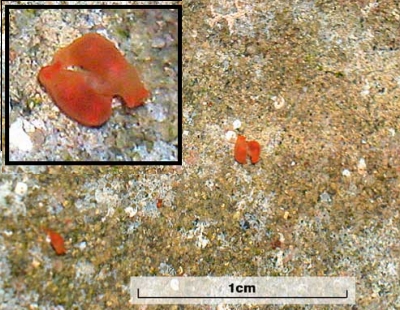
Concerning message #2306:
Hi Bill and everyone!
I wish to send to you photos of Vayssieria caledonica (Risbec, 1928). This species is very very common here on the Sunshine Coast. Under rocks at low tide. I have some interesting photos to share with you all. A microscope photo of the animal and it's egg mass. Also a photo of it mating. This animal never gets longer than 2.5 mm, upon my observations over the last 6 years. I have seen here at Alexandra Headland on one intertidal visit about 50 or more animals. Tube worm seem to be their favourite food source.
Locality: Alexandra Headland, Mooloolaba, 100 mm, Queensland, Australia, Pacific Ocean, 09 February 2008, Intertidal. Length: 1-2.5 mm. Photographer: Gary Cobb.
Gary Cobb
gary@nudibranch.com.au
Cobb, G.C., 2008 (Sep 12) Vayssierea felis from sthn Queensland. [Message in] Sea Slug Forum. Australian Museum, Sydney. Available from http://www.seaslugforum.net/find/21380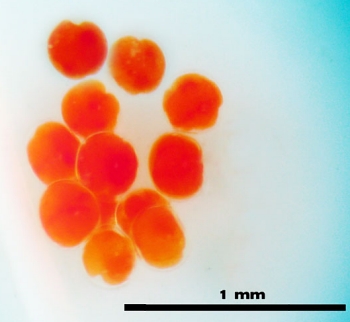
Dear Gary,
Thanks for these photos. I think we should use the name Vayssierea felis. I don't think there is much logic in not using Collingwood's name because he did not describe the radula and then using Risbec's much later name when his description of the radula is so wrong it could be another species. This small red-orange species, with large direct-developing eggs, and which feeds exclusively on tube worms, such as Spirorbis, with a spiral calcareous shell, is found throughout the Indo-West Pacific. It is easy to see how it has such a wide distribution as it is often found on drifting bits of brown algae on which tube worms are often found.
Best wishes,
Bill Rudman
Re: Vayssierea on the Forum
April 22, 2000
From: Alexander Martynov
Dear Bill,
I was happy to read my message with your valuable language corrections. One important change is needed though. The paragraph beginning "Both the present ...." is a direct quote by me from Baba, 1937.
Sincerely,
Alexander.
martyn@AM3963.spb.edu
Martynov, A., 2000 (Apr 22) Re: Vayssierea on the Forum. [Message in] Sea Slug Forum. Australian Museum, Sydney. Available from http://www.seaslugforum.net/find/2306Dear Martyn,
Sorry about that. I have changed your original message so that it's quite clear that Baba was thinking much the same as us over 60 years ago.
Best wishes,
Bill Rudman.
Vayssiereidae - further thoughts
April 20, 2000
From: Alexander Martynov
Dear Bill,
Here are my comments and picture on the recent Forum's discussion on Vayssiereidae. Please, please excuse my English. I am not very experienced.
Yours sincerely
Alexander
Subject: New thoughts on the genus Vayssierea.
For a long time our understanding about the family Vayssiereidae has been unclear. The family consists only two genera, but their distinguishing features are hardly understandable, and the genera have so few species - but how many really?... Recently we have new excellent data on the radula of Vayssiera caledonica, and now the radical suggestion for Vayssiereidae - only one genus and only one species from South Africa to Japan.
When I look at Collingwood (1881), I found that figures of Trevelyana felis on the color plate undoubtedly belong to Vayssiereidae. However, are the differences between radula of Japanese Okadaia elegans Baba, 1930 and Vayssierea caledonica Risbec, 1928 really sufficient to keep them separate? I have studied the radula of V. elegans from Peter the Great Bay and vicinities, Japan Sea and from the Pacific side of Kunashir Island (Kurile Islands) . All these radula always have no central tooth ( I used only light microscop - but I don't think I missed anything) and, that, more remarkable and important - denticles on the first lateral teeth are short, and in general like figures in a paper of Baba (1937). Vayssierea caledonica, from new SEM images in Southern Synthesis and on the Forum, always possesses a rudimentary central tooth and relatively long denticles on the first lateral tooth (despite what the drawings of teeth of Vayssierea caledonica in the first description made in Risbec's characteristic elongated manner, the long denticle on the first lateral are more like the recent SEM image, than Baba's pictures).
It is a clear difference between the species, which I can't ignore. In this light, taxonomic placement of Vayssierea felis became again unclear, because ther is no data on its radula. Both V. caledonica and V. elegans can theoretically inhabit the Chinese coast, where V. felis was found. Thus, the name V. felis can't simply be applied to all Vayssiereidae. Only a study of the type material, if it exists can solve the problem.
It is interesting to note the words of Baba (1937: p 149):
"Both the present species and V. caledonica Risbec differ much from Fucola rubra Quoy & Gaimard in having a pair of separate rhinophores a short distance behind the anterior end of the head (in Fucola rubra the rhinophores are connate, lying at the extreme anterior end of the head). It is suggested here that Trevelyana felis Collingwood, though regarded by Collingwood himself as an immature species of Trevelyana (Gymnodoris) and by Pruvot-Fol (1933, 1934) as belonging to the little known genus Fucola, might be a tiny, gill-less, scarlet-tinted Dorid, closely allied to either of the species, V. caledonica Risbec or O. elegans Baba."
To reach a conclusion, it is necessary to reinvestigate of the radula of vayssiereids by SEM from all known main localities and also, as far as possible, type material V. caledonica, V. elegans, V. cinnabarea (Ralph, 1944) . Before this, Vayssierea caledonica and V. elegans it is only species that really can to understand. V. tecticardia (Slavoshevskaya, 1971) is junior synonym of V. elegans. Still unknown reproductive system of type species of genus Vayssierea - V. caledonica. From external appearance and radula, genus Okadaia can be referred to the synonymy of Vayssierea, as already suggested by Bill Rudman on the forum. And did you confirm from your study the presence of ciliated 'mamelons' around anus of V. caledonica? These 'mamelons' were found by Risbec, and regarded by Baba as rudimentary gills, and one of differences of Vayssierea from Okadaia.
This situation with species of Vayssierea is for me like in the genus Berthellina - all orange externally, but different internally (Cervera, Gosliner, Garcia-Gomez, 1999). Interestingly, the earliest book, where I found combination Vayssierea elegans (Baba, 1930) is Higo, Goto, 1993 - A Systematic List of Molluscan Shells from the Japanese Is. and the Adjacent area. I regret, I don't know the source of the list of Nudibranchia in that checklist. Probably they used consultations of Kikutaro Baba or his entire list?
The family Vayssiereidae from it's birth, didn't had a normal home - Collingwood thought that Trevelyana felis was only a juvenile without gills. Risbec placed Vayssiereidae in the Sacoglossa, Ralph created a new genus near to the pelagic Phyllirhoidae. The radular morphology of some Gymnodoris and Vayssierea perhaps suggests that Vayssiereidae is a reduced descendant of the Gymnodorididae. Baba (1930) placed his Okadaia in the family Polyceridae s.l. Vayssiereidae is a family of dorids, but their relationship is unclear.
Alexander Martynov
Zoological Institute,
St.Petersburg
Russia
martyn@AM3963.spb.edu
Martynov, A., 2000 (Apr 20) Vayssiereidae - further thoughts. [Message in] Sea Slug Forum. Australian Museum, Sydney. Available from http://www.seaslugforum.net/find/2298Dear Alexander,
Thanks very much for your thoughtful comments. Firstly I have separated off your observations on the living animals and photo of V. elegans to a separate message.
Secondly, don't worry about your English. It is a lot better than my Russian, German, Portugese, Japanese etc. I couldn't write an intelligible message to a Forum in any of those languages. I have rewritten a few parts of your message but have tried to leave it as untouched as possible to retain the cosmopolitan flavour of out world wide Forum. Please let me know if I have misinterpreted anything you said.
About your comments. I think the first step is to clarify the radular differences. Dr Baba's studies on Japanese specimens were very detailed and diligent, and similarly Ralph's work in New Zealand was supervised by equally diligent workers. And I am sure you have looked very hard at the radula in your material. However light microscope mounts can sometimes mislead. The central tooth is very reduced and could easily become transparent in a light microscope mount. The other possibility is that this very reduced tooth can be present or absent within the species. This certainly occurs with the reduced central tooth of some chromodorids.
It is interesting thought that as I mentioned at the top of the page, D.K. Young was the first one to report the central tooth, and that was from Okinawan specimens, and with a light microscope. If you wish to send me a few specimens from Peter the Great Bay, or anyone wishes to send me some from Japan, I would be happy to photograph them in our Scanning Electron Microscope and post the results on the Forum.
Best wishes,
Bill Rudman.
Vayssierea from the Russian Pacific
April 20, 2000
From: Alexander Martynov
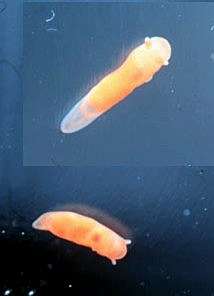
Dear Bill,
Here are some ecological notes on Vayssiera elegans in Peter the Great Bay:
From intertidal to about 5 m. Most common nudibranchs in all seasons of year. Found mainly under stones, with Spirorbidae (for example, Neodexiospira brasiliensis (Grube, 1872) (Det. Rzhavsky A.V.) Also found on the brown algae Laminaria japonica, L. cichorioides, Costaria costata, more rarely on Cystoseira crassipes, Sargassum miyabei and S. pallidum.
Reproduction from end of May to September. During the copulation, inverted copulative apparatus of partners don't penetrate directly to the genital openings, but joined to nearly entire mass (including inverted part of distal female part), situated between the specimens. Within "copulative mass" you can see the thin ejaculatory ducts penetrating the female parts. Spawn mass small, flattened, from round to bean-shape, attached usually to a stones. Usually about 10 eggs of red color
Distribution in the Far-East Seas of Russia: Japan Sea - Peter the Great Bay and Kievka Bay (about 100 km to north from Kievka I didn't find this species). Kurile Islands - Kunashir Id. (both Pacific and Okhotsk Sea sides)
PHOTO: Vayssiera elegans (Baba, 1930).
Japan Sea, Peter the Great Bay, Ussuri Bay, Sobol' Bay. June 1992, intertidal, under the stones. Collected A.V. Martynov, A.V. Chernyshev
Best wishes,
Alexander Martynov
Zoological Institute, St.Petersburg
Russia
martyn@AM3963.spb.edu
Martynov, A., 2000 (Apr 20) Vayssierea from the Russian Pacific. [Message in] Sea Slug Forum. Australian Museum, Sydney. Available from http://www.seaslugforum.net/find/2299Dear Alexander,
Thanks for the information. As I have said at the Top of the Page, I am putting your information about vayssiereids on this one page [Vayssierea felis] until we sort out just how many species we think there are.
best wishes,
Bill Rudman.
Quoy & Gaimard's 'Fucola rubra'
April 18, 2000
From: Bill Rudman
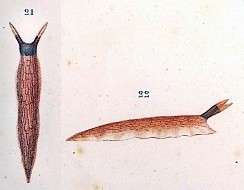
In reference to Kathe Jensen's message about Fucola rubra Quoy & Gaimard, 1832, here is the original illustration. It is described as having a violet head and a pattern of red longitudinal lines on the body. Found somewhere in the Atlantic Ocean.
Bill Rudman.
References.
•Pruvot-Fol, A (1934) Les opisthobranches de Quoy & Gaimard. Archives du Museum National d'Histoire Naturelle, Paris, series 6(11): 13-89,Pl.1.
•Quoy, J.R & Gaimard, J.P (1832) Voyages de decouvertes de l`Astrolabe pendant les annees 1826-1829 sous le commandement de M.J. Dumont d`Urville. Zoologie 2: 1-686.[p321-322, Pl 24 figs 21, 22]
Re: Radula & references for Vayssierea
April 16, 2000
From: Kathe R. Jensen
Dear Bill,
When I see pictures of Vayssierea spp. I am always reminded of a colour figure I saw in the Atlas-part of Quoy & Gaimard's opisthobranchs from the Astrolabe expedition (of course I do not have access to that magnificent work here in Thailand, so I have not been able to refreshen my memory). The species name was Fucola rubra, and at first glance it looked like a tiny Elysia, but the colour was all wrong (dark red, almost purple). Have you seen this plate? And what do you think of it? Could it be Vayssierea?
All the best,
Kathe
jensen@ait.ac.th
Jensen, K.R., 2000 (Apr 16) Re: Radula & references for Vayssierea. [Message in] Sea Slug Forum. Australian Museum, Sydney. Available from http://www.seaslugforum.net/find/2278Dear Kathe,
Yes I have considered Fucola rubra but it is from the Atlantic Ocean and the specimen is lost. The earliest anatomical description is Risbec's (1928) for Vayssierea caledonica, but Collingwood's description of the living animal can hardly be mistaken for anything else. I'll post a copy of Quoy & Gaimard's Fucola when I get a chance.
Best wishes,
Bill Rudman.
Re: Okadaia - Vayssierea
April 16, 2000
From: Irina Roginskaya
Dear Bill!
Okadaia elegans Baba is one of the most common nudibranch in the intertidal environment of Popov Island, Sea of Japan. In August- October 1969 I could observe there these red little creatures, just like the one displayed by Yasuhiro Shirai. Usually the masses of these molluscs were attached to sea weeds, often to Chordaria flagelliformis, and to the leaves of Zostera . Their mucous spawns, attached near by, were small, in the form of little sausages (~ 1.5 whorls). The bright orange or rosy-red eggs could be seen through the semitransparent stroma of the egg mass. Usually there were 12-16 eggs in one spawn. Our Okadaia also have direct development. In August I could find the early spawns, containing eggs before cleavage, as well as the egg masses with slowly rotating veligers, densely packed in the egg capsules (without larval shell), and also the old spawns with larvae not long before hatching. And often the crawling, just hatched, young Okadaias, transparent, slightly yellowish ,with black eyes, with body length ~0,5 mm , already bearing rhinophores, were also seen.
In aquarium the young crawling Okadaia hatched from the spawn, found in the field 20 August 1969 with uncleaved eggs, after 10 days of development (01 September 1969). At the beginning of October Okadaia were also very common, their length attained 1.5-2.1mm.
According to Baba (1937) I determined this mollusk as O. elegans Baba. I am sure we were dealing with the same species. But in 1971 L. Slavoshevskaja described this species, also from the Sea of Japan, as new - Okadaia tecticardia Slavoshevskaja, 1971, based on some anatomical differences from the specimens studied by Baba. •Slavoshevskaya L.V. (1971) A new aberrant nudibranchiate mollusc from the Sea of Japan. Explorations of the Fauna of the Seas, VIII(XVI). Fauna and Flora of the Possiet Bay of the Sea of Japan (Hydrobiological Investigations by diving method). Nauka, Leningrad. Zoological Institute of the Academy of Sciences of the USSR.
I have often seen our O. elegans floating in waves without any substrate - perhaps also the way to secure its widespread distribution? In fact it seems possible that all these red animals belong to a single species - but in 1969 I thought in another way.
Best wishes,
Irina S.Roginskaya.
Irina7@hotmail.com
Roginskaya, I., 2000 (Apr 16) Re: Okadaia - Vayssierea. [Message in] Sea Slug Forum. Australian Museum, Sydney. Available from http://www.seaslugforum.net/find/2279Okadaia from Japan?
April 13, 2000
From: Yasuhiro Shirai

Dear Bill,
I found this animal on rock and sand. I saw 5 or 6 individuals nearby. They are very small animals. Their length were 1.5mm-2mm!
Could you please identify this animal for me.
Data:
Location: Shima Pref. Mie Japan
Length: 2mm
Water temperature: 15C
Date Feb. 2000
Depth: -2m
Crawling on rock or sand
Best regards,
Yasuhiro Shirai
yasuhiro@e-net.or.jp
Shirai, Y., 2000 (Apr 13) Okadaia from Japan?. [Message in] Sea Slug Forum. Australian Museum, Sydney. Available from http://www.seaslugforum.net/find/2261Dear Yasuhiro,
Yes it could possibly be the species you suggest. Okadaia is one name for the genus. Have a look at the top of the page to see the many names applied to this species.
In correpondence, Dr Baba, considers specimens from Japan, which he calls Okadaia elegans, distinct from other west Pacific animals, based on various characters, including the number of large red eggs seen through the body wall. As I discuss at the Top of the Page, I think there is probably one widespread species.
Best wishes,
Bill Rudman.
Radula & references for Vayssierea
April 13, 2000
From: Bill Rudman
I have added a couple of pages of information on Vayssierea felis also known as Okadaia elegans and Pellibranchus cinabareus.
See V. felis References.
See V. felis - Radular Morphology.
Best wishes,
Bill Rudman.
